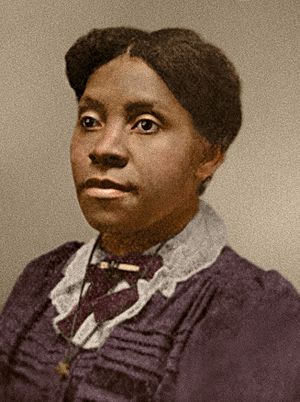Callie House facts for kids
Quick facts for kids
Callie Guy House
|
|
|---|---|
 |
|
| Born | 1861 |
| Died | 1928 (aged 66–67) |
Callie House (1861 – 1928) was an important leader who fought for fairness for former enslaved people in the United States. She led one of the first groups to ask for reparations (which means making up for past wrongs, often with money) for slavery. This group was called the National Ex-Slave Mutual Relief, Bounty and Pension Association.
Contents
Callie House's Story
Callie House was born into slavery in Rutherford County, Tennessee, near Nashville, Tennessee. When she was 22, she married William House. They had six children together. After William passed away, Callie worked as a washerwoman to support her family.
When she was 36, Callie House started organizing many people to ask the U.S. government for reparations. She built a strong movement, but because of her work, she was unfairly put in prison in 1916.
Fighting for Former Slaves' Rights
After slavery officially ended with the 13th Amendment, many former enslaved people still faced very tough lives. They often had to work on farms for others (this was called sharecropping) and had no money or resources of their own. The government didn't offer them any financial help.
Callie House and another leader named Isaiah H. Dickerson traveled to states where slavery used to be common. They gathered support for their group, the National Ex-Slave Mutual Relief, Bounty and Pension Association (MRB&PA).
Why Pensions?
At that time, many Americans believed that elderly war veterans should receive pensions (regular payments) for their service. This gave former enslaved people hope that they might also get payments for all the unpaid work they had done. The idea of pensions for former slaves grew stronger.
The MRB&PA officially started on August 7, 1897. It had two main goals:
- To ask Congress for a law that would give money (reparations) to former enslaved people.
- To offer help and cover burial costs for its members.
By the late 1890s, the MRB&PA became the biggest group pushing for ex-slave pensions. It had hundreds of thousands of members.
Government Opposition
As the group grew, the government started watching them closely. Three federal agencies—the Bureau of Pensions, the Post Office Department, and the Department of Justice—wanted to stop this movement. The Post Office Department accused groups like the MRB&PA of fraud, saying they were using the mail to trick former slaves.
On September 20, 1899, the MRB&PA was given a "fraud order." This meant they couldn't send mail or receive money orders. Callie House tried to fight this, saying it went against their rights to free speech and equal treatment. She even hired a lawyer. But the Post Office Department was determined to limit the MRB&PA's influence.
Meanwhile, the bill asking Congress for pensions was not taken seriously. A committee decided to put it off indefinitely. Callie House reminded them that the U.S. Constitution gives citizens the right to ask Congress to fix problems.
When Isaiah Dickerson died in 1909, Callie House became the main leader of the MRB&PA and the movement. Even with problems using the mail, the MRB&PA kept going strong under her leadership. Callie House also decided to take the fight for pensions to the courts.
The Reparations Lawsuit
In 1915, Callie House led the association in filing a big lawsuit called Johnson v. McAdoo. They sued the U.S. Treasury Department for $68 million. This money was from a cotton tax collected between 1862 and 1868. The group argued that this money belonged to them because the cotton was produced by them and their ancestors through forced labor.
This was the first time Black Americans had sued the U.S. government at the federal level for reparations. However, the U.S. Court of Appeals for the District of Columbia said they couldn't sue the government because of "governmental immunity." This means the government usually can't be sued without its permission. The U.S. Supreme Court agreed with this decision.
Arrest and Imprisonment
The U.S. Postal Service's accusations of fraud against Callie House led to her arrest in 1916. She was found guilty by a jury made up of all men and all white people. She was sentenced to one year in prison in Jefferson City, Missouri.
Callie House's arrest made it harder for the national reparations movement to continue. While some local groups kept fighting until the 1930s, the movement lost much of its strength.
Callie House's Legacy
In 2015, Vanderbilt University honored Callie House. Their African American and Diaspora Studies Program renamed its research center the Callie House Research Center for the Study of Black Cultures and Politics. This shows how important her work and leadership were.


